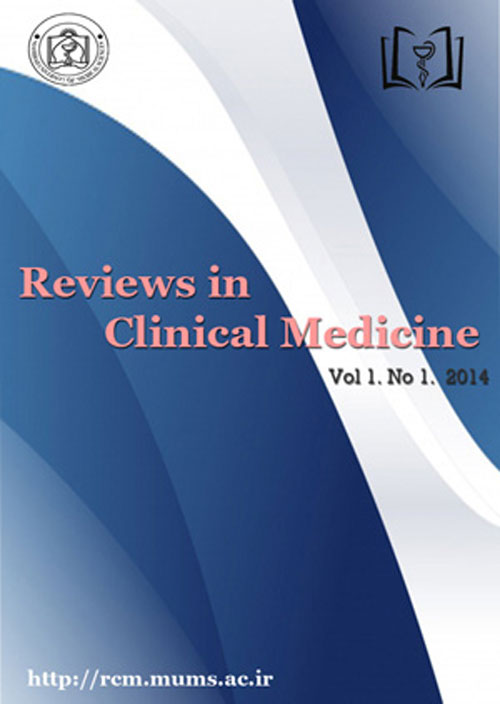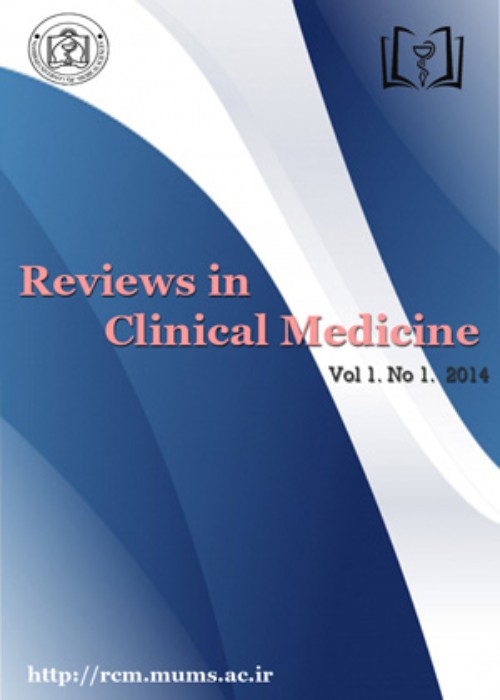فهرست مطالب

Reviews in Clinical Medicine
Volume:9 Issue: 1, Winter 2022
- تاریخ انتشار: 1401/07/11
- تعداد عناوین: 8
-
Pages 1-5IntroductionDespite an agricultural country, India confronting malnutrition as a major public health challenge, where every second child is at risk of malnutrition. The nation ranking second in population with disproportionate rural and urban demography, further poor penetration of government assisted programs in remote, underserved areas fuelling the malnutrition in rural areas.MethodsThis cross-sectional study was conducted in Department of Community Medicine of Rohilkhand Medical College and Hospital. Total 465 schoolchildren in rural and urban areas of Bareilly district were screened for malnutrition and their socio-demographic profiles were studied.ResultsOverall, the prevalence of malnutrition in schoolchildren of Bareilly district was 40.2%. Fraction contributed by urban and rural territories was 35.2% and 43%, respectively. The prevalence of malnutrition was found higher in rural area as compared to urban area and the difference was statistically significant (P<0.001).ConclusionThe study shows 43% prevalence of malnutrition in rural areas and under nutrition was the main cause of malnutrition attributed by poverty and illiteracy. However, urban areas reported 7.8% lower prevalence of malnutrition, but alarming trends of overweight and obesity 15.2%.Keywords: Malnutrition, Undernutrition, Rural, urban area, Schoolchildren
-
Pages 6-10IntroductionBased on serological studies, the prevalence of Helicobacter pylori infection in Iranian adults is up to 80%. Gastritis, peptic ulcer, and gastric adenocarcinoma are common clinical outcomes of this infection in Iran. Since antibiotic resistance patterns of Helicobacter pylori are geographically different, local studies are highly required.MethodsEighty isolates of Helicobacter pylori were obtained from patients referred to the endoscopy unit of Ghaem Hospital in Mashhad. Demographic features including age, gender, and symptoms were recorded before the sampling. The antibiotic susceptibility patterns of isolates were determined for the five common antibiotics used for the treatment of Helicobacter pylori infection. The agar dilution method was used to evaluate the antibiotic resistance patterns.ResultsThe patterns of antibiotic resistance were determined, and 41.2%, 13.7%, 8.7%, 6.6%, and 6.6% of isolates were resistant to metronidazole, clarithromycin, amoxicillin, tetracycline, and furazolidone, respectively.ConclusionOur study demonstrates that the overall rate of antibiotic resistance of Helicobacter pylori especially in the case of metronidazole has increased over time. The resistance rates are generally higher in the age range of 30-60 years and in females for the case of metronidazole. This reminds us of the need for a continuous monitoring program of antibiotic susceptibility patterns.Keywords: Helicobacter pylori, Agar dilution, Antibiotic resistance
-
Pages 11-19Introduction
Despite an agricultural country, India confronting malnutrition as a major public health challenge, where every second child is at risk of malnutrition. The nation ranking second in population with disproportionate rural and urban demography, further poor penetration of government assisted programs in remote, underserved areas fuelling the malnutrition in rural areas.
MethodsThis cross-sectional study was conducted in Department of Community Medicine of Rohilkhand Medical College and Hospital. Total 465 schoolchildren in rural and urban areas of Bareilly district were screened for malnutrition and their socio-demographic profiles were studied.
ResultsOverall, the prevalence of malnutrition in schoolchildren of Bareilly district was 40.2%. Fraction contributed by urban and rural territories was 35.2% and 43%, respectively. The prevalence of malnutrition was found higher in rural area as compared to urban area and the difference was statistically significant (P<0.001).
ConclusionThe study shows 43% prevalence of malnutrition in rural areas and under nutrition was the main cause of malnutrition attributed by poverty and illiteracy. However, urban areas reported 7.8% lower prevalence of malnutrition, but alarming trends of overweight and obesity 15.2%.
Keywords: lifestyle, Socioeconomic, adolescent girls, Artificial neural network, vitamin D supplementation -
Pages 20-27Introduction
Routinely used inflammatory markers such as ESR and CRP are suggested to suspect post-operative infection at an early stage. Therefore their normal trend after arthroplasty surgeries need to be known and their variation from that trend need to be understood.
MethodsA prospective observational study was conducted. 75 patients undergoing THR or HRA surgeries of hip or TKR surgeries fulfilling the inclusion and exclusion criteria were considered for the study. Blood samples were collected preoperatively and postoperatively on day 1, 3, 5, 7 and 15 after surgery and sent to measure ESR and CRP values. Surgical site was assessed for presence of any discharge, which was sent for culture. Presence of any growth after 48 hours of incubation was diagnosed as infection.
ResultValues of both ESR and CRP raised after surgery. ESR reached its peak value on POD 5 while CRP reached its peak value on POD 3. Both ESR and CRP declined thereafter. On correlating these trends with infected cases, we reported a statistically significant correlation of CRP with infection on POD 15. However, ESR values did not show any significant correlation with infection in starting 15 days post-operatively.
ConclusionThere is a significant variation in levels of ESR and CRP after arthroplasty surgeries of lower limb. In infected cases, there is a deviation from this normal trend, that can be used to suspect post-operative infection. However, none of these parameters can be used to suspect it in starting 7 days after surgery.
Keywords: ESR, CRP levels, Hip, Knee Arthroplasties, post operative infection -
Pages 28-33IntroductionDiabetes (DM) is a type of metabolic disorder that its types are generated by collectingof genetic and environmental risk agents. Here, the association between HSPB1 polymorphism as a genetic risk factor and DM was investigated.MethodsTotal 690 participants from MASHAD cohort study population were recruited into the study.Anti-HSP27-level was assessed followed by genotyping using Taqman®-probes-based assay. Anthropometric, demographic and hematological/biochemical characteristics were evaluated. Kaplan-Meier curves were utilized, while logistic regression models were used to assess the association of the genetic variant with clinical characteristics of population.ResultsFinds was shown there are meaningful differences among groups of age, height, waist circumference, systolic blood pressure, FBG,TG, HDL-C, and hs-CRP, and was no big -significant difference between theexists in different HSP27 SNP in the two studied groups (with and without DM), also was no remarkable relation between genetic forms of HSPB1and T2DM. This investigation was the first research that analyzed the relationship between the genetic type of the HSPB1 gene (rs2868371) and Type 2 diabetes (DM2). In our population, the CC genotype (68.1%) had a higher prevalence versus GC (26.6%) and GG (5.3%) genotypes and the data shown that no genetic difference of HSPB1 gene polymorphism (rs2868371) was related with DM2.ConclusionHSPB1 polymorphism, rs2868371, was not associated with type 2 diabetes mellitus.Keywords: Diabetes Mellitus, HSPB1, rs2868371, Polymorphism
-
Pages 34-37
Population is most important asset in each country. Fertility is one of the main issues in demography. It is also an important element of population growth during recent years. Iran’s population has been experiencing important changes in its age structure due to the continuous decline in fertility. Presently, Iran is one of the countries that has low fertility rates. These changes, on the one hand, bear substantial considerations in terms of economic, social, policy and planning making and planning strategies, on the other hand religious government cannot stay indifferent to the religious priorities in the social, economic and family planning, thus, statesmen need to be aware of this phenomenon. This study intends to introduce Quranic guidelines and Islamic traditions concerned with fertility. In this narrative review, documents without a time limit and using the keywords Quran, Fertility, Population, Islam and Iran, alone or in combination in the alone or in combination in the Persian and English databases were searched. Also fully reviewed all 114 Surahs and other religious sources to find the verses and narrations and hadiths specifically referring to the fertility. The documents were summarized and critiqued. In Quran, there are various verses which point to infertility and human reproduction. in Surahs Al-Shura, Al-Nuh, Al-Nour , Al-Anam, Al- Nisa, Al- Tawbah, Al- Ahzab, Al- Baqarah, Al- Qiyamat, Al- Tariq, Al- Fatir, Al- Qasas, Al- Momen, Al- Ra’d, Al- Anbiya, Al- Talaq, l- Al-Imran, Al- An’am, Al- Isra, Al- Mursalat. Since being ignorant to the issue of fertility in the current situation in Iran can lead to a decrease in political, social, and economic power, it is rational to pay special attention to fertility based on the mentioned cases, and especially, the importance of the concept of fertility in the Quran and Islamic sources.
Keywords: Islamic Guidelines, Population, Fertility -
Pages 38-44
Hemorrhage can result in an increased mortality and morbidity. There are a variety of options to assist the surgeon in achieving hemostasis. Modalities that result, or assist, in hemostasis were included under the term Hemostatic Modalities. Due to the variety of hemostatic modalities available, choosing the correct modality tailored for each situation and patient can be confusing. The aim was to classify and organize the different hemostatic modalities in the armamentarium available to the surgeon. Hemostatic modalities can be classified into systemic and local modalities. Systemic hemostatic modalities include blood component therapy and anticoagulant antidotes. Local hemostatic modalities are subdivided into vasoconstrictors, electrical devices, mechanical modalities, endovascular modalities and topical hemostatic agents. Topical hemostatic agents can be further subclassified into agents that function with an intact or dysfunctional patient coagulation system, i.e. “independent of the coagulation system”, and those that only function with an intact patient coagulation system, i.e. “dependent on the coagulation system”. Classifying hemostatic modalities allows for a more informed decision and a structured approach when choosing the appropriate modality. The different classes, as well as within the classes, are by no means isolated and can be used concurrently, depending on the situation, resulting in a synergistic effect for hemostasis.
Keywords: Surgical Procedures, Operative, Equipment, supplies, Therapeutics -
Pages 45-48Introduction
paraquat is a cheap and easy access herbicide which its intoxication is limited in Iran. The current study aims to provide some epidemiologic data within paraquat poisoning from the most crowded referral center of clinical toxicology in Iran.
MethodsWe investigated the paraquat poisoning patients who were admitted to Loghman-Hakim Hospital in Tehran, Iran from 2008 to 2016.
ResultsA total of 12 patients participated in this study, 50% of these patients were between 10-20 years old, 41.7% were between 26-40 years old, and 8.3% were above 55 years old. About 83.3% were male, and 16.7% were female. Treatments which were given in the hospital include cyclophosphamide (58.3%), cortisol (75%), vitamin C (50%), vitamin E (83.3%), N-acetyl cysteine (83.3%). 66.6 percent of hospitalized patients required invasive measures to preserve their airways, with 3.33 percent undergoing tracheostomy and the same percentage undergoing intubation. There were five fatalities among the patients, three of which were related to pulmonary and renal failure.
ConclusionsThis study indicates that the majority are younger than 40 years and males. Prevention and limited access to this substance is necessary in terms of the lack of antidote.
Keywords: Paraquat poisoning, intoxication, Epidemiology


